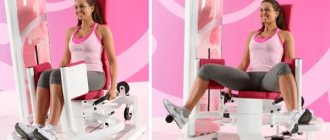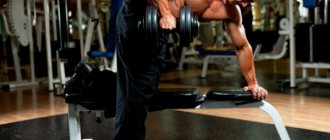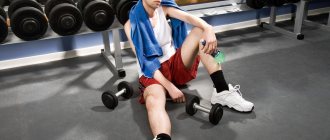Workout No. 1. General preparation
As part of this workout, we work large muscle masses, as well as the arms and tendon ligaments. Pay attention to the order in which you perform the exercises. We will perform movements that do not involve the target muscles at the end of the workout. The same applies to the deadlift, which in this complex is used for the final “finishing” of the forearms.
The training program for general training looks like this:
| Exercise | Weight | Approaches | Repetitions | Rest in minutes |
| Pull-ups | Own weight + 10 kg | 5 | 10 | 1,5 |
| Farmer's Walk | 2 to 30 | 5 | 10-20 seconds | 1,5 |
| Holding weight on outstretched arms while standing | 120 | 3 | 15-25 seconds | 1,5 |
| Barbell curl | 45 | 3 | 10 | 1 |
| French press standing | 40 | 3 | 10 | 1 |
| Dumbbell rotation | 20 | 3 | 10 | 1 |
| Squats | 90 | 5 | 15 | 1,5 |
| Dips | Own weight + 10 kg | 5 | 10 | 1,5 |
| Deadlift | 100 | 5 | 15 | 1,5 |
In dynamics:
Day 2
| Exercise | Weight | Approaches | Repetitions | Rest |
| Pull-ups | Own weight + 10 kg | 6 | 10 | 1,5 |
| Farmer's Walk | 2 to 30 | 6 | 10-20 seconds | 1,5 |
| Holding weight on outstretched arms while standing | 120 | 4 | 15-25 seconds | 1,5 |
| Barbell curl | 45 | 4 | 10 | 1 |
| French press standing | 40 | 4 | 10 | 1 |
| Dumbbell rotation | 20 | 4 | 10 | 1 |
| Squats | 90 | 6 | 15 | 1,5 |
| Dips | Own weight + 10 kg | 6 | 10 | 1,5 |
| Deadlift | 100 | 6 | 15 | 1,5 |
Day 3
| Exercise | Weight | Approaches | Repetitions | Rest |
| Pull-ups | Own weight + 10 kg | 7 | 10 | 1,5 |
| Farmer's Walk | 2 to 30 | 7 | 10-20 seconds | 1,5 |
| Holding weight on outstretched arms while standing | 120 | 5 | 15-25 seconds | 1,5 |
| Barbell curl | 45 | 5 | 10 | 1 |
| French press standing | 40 | 5 | 10 | 1 |
| Dumbbell rotation | 20 | 5 | 10 | 1 |
| Squats | 90 | 7 | 15 | 1,5 |
| Dips | Own weight + 10 kg | 7 | 10 | 1,5 |
| Deadlift | 100 | 7 | 15 | 1,5 |
Day 5
| Exercise | Weight | Approaches | Repetitions | Rest |
| Pull-ups | Own weight + 12 kg | 5 | 10 | 1,5 |
| Farmer's Walk | 2 to 32 | 5 | 10-20 seconds | 1,5 |
| Holding weight on outstretched arms while standing | 125 | 3 | 15-25 seconds | 1,5 |
| Barbell curl | 47,5 | 3 | 10 | 1 |
| French press standing | 42,5 | 3 | 10 | 1 |
| Dumbbell rotation | 22 | 3 | 10 | 1 |
| Squats | 95 | 5 | 15 | 1,5 |
| Dips | Own weight + 12 kg | 5 | 10 | 1,5 |
| Deadlift | 105 | 5 | 15 | 1,5 |
Day 10
| Exercise | Weight | Approaches | Repetitions | Rest |
| Pull-ups | Own weight + 15 kg | 5 | 10 | 1,5 |
| Farmer's Walk | 2 to 35 | 5 | 10-20 seconds | 1,5 |
| Holding weight on outstretched arms while standing | 130 | 3 | 15-25 seconds | 1,5 |
| Barbell curl | 50 | 3 | 10 | 1 |
| French press standing | 45 | 3 | 10 | 1 |
| Dumbbell rotation | 24 | 3 | 10 | 1 |
| Squats | 100 | 5 | 15 | 1,5 |
| Dips | Own weight + 15 kg | 5 | 10 | 1,5 |
| Deadlift | 110 | 5 | 15 | 1,5 |
There is no arm wrestling in this scheme - after properly conducted general training, you will have no strength left to fight.
Exercises
Let's get one thing straight: wrist flexion alone is not enough! To become a great arm wrestler, you will have to master many other skills and abilities!
Hammer or single-sided dumbbell lift
For this exercise, you will need a lever with a weight on one end, such as a hammer or sledgehammer. We recommend purchasing a single-sided Hammer Bar dumbbell, which is designed specifically for this exercise and has a thick 6cm handle for better grip. Or buy a Heavy Handle Dumbbell with a five-centimeter thick handle. Below are photos showing the “Hammer Bar”. Unlike projectiles with a thin handle, this projectile better simulates a grip in the process of martial arts, and therefore more effectively develops the strength of the necessary muscle groups.
And the exercise itself is very simple: lift the weight by bending the wrist joint, and not by moving the entire arm. Carefully study the pictures that show how to perform this movement.
The next exercise is also lifting a single-sided dumbbell, but not forward, but backward. Once again, please note that the forearm must be motionless, movements are performed exclusively in the wrist joint.
Extension of the hand with weights
This exercise will literally BLOW UP your forearm. I guarantee that after extending your wrist using the Hercules Bar, your forearm muscles will burn like never before. And not only will your forearm be exhausted to the limit - even your fingers will be on the verge of exhaustion! We do not recommend doing this exercise if you will soon be typing text on the keyboard - your fingers simply won’t obey you! If you don't have a Hercules Bar, try doing extensions with a regular dumbbell or barbell. The main problem is that when working with heavy weights, the handle can slip out of your hands literally halfway, and all because only your thumb is holding the dumbbell from below. And since the thumb is much weaker than the forearm, strengthening the muscles of the latter with a regular barbell (dumbbell) is quite problematic. In other words, the thumb acts as the limiting factor during training, and you will never get to the forearm.
The Hercules Bar trainer eliminates this problem due to the stops that fix the projectile on the back of the hand. The supports evenly distribute the weight of the dumbbell, and the thumbs are no longer “limiters” during forearm muscle training. The projectile will never slip out of your hands, allowing you to truly blast your forearms. Photos are attached.
Please note that this exercise can be performed without holding the handles at all; the stops on the back of the hand securely fix the projectile. This allows you to pay full attention to working with your forearms, without being distracted by your thumbs.
Horizontal lift arm
I call the next exercise in our complex the horizontal lever raise. I don’t have very good photographs, but the essence of the exercise is to take a long lever (preferably with a light weight) and do everything as shown in the photographs:
Workout #2: Developing Target Muscles
We focus on developing the muscles of the arms and forearms. We work on ligaments and tendons using static exercises:
| Exercise | Weight | Approaches | Repetitions | Rest |
| Arm wrestling | — | 5 | — | 45 seconds |
| Farmer's Walk | 2 to 25 | 3 | 40-60 seconds | 1 |
| Hanging on a thick horizontal bar | — | 3 | 40-60 seconds | 1 |
| Reverse push-ups | — | 3 | 12 | 1 |
| Hammer | 20 | 3 | 10 | 1 |
| Reverse grip barbell curl | 35 | 3 | 10 | 1 |
| Narrow push-ups | — | 3 | 10 | 1 |
| Push-ups (standing position) on fingers | — | 3 | 6 (20 seconds) | 1 |
| Expander squeezing | 80 | 3 | 6 | 1 |
| Rope climbing | — | 7 | — | 15 seconds |
| Arm wrestling | — | 5 | — | 45 seconds |
The workout begins with 5 rounds of arm wrestling. The work must also be completed through struggle.
In dynamics it looks like this:
Day 2
| Exercise | Weight | Approaches | Repetitions | Rest |
| Arm wrestling | — | 6 | — | 45 seconds |
| Farmer's Walk | 2 to 25 | 4 | 40-60 seconds | 1 |
| Hanging on a thick horizontal bar | — | 4 | 40-60 seconds | 1 |
| Reverse push-ups | — | 4 | 12 | 1 |
| Hammer | 20 | 4 | 10 | 1 |
| Reverse grip barbell curl | 35 | 4 | 10 | 1 |
| Narrow push-ups | — | 4 | 10 | 1 |
| Push-ups (standing position) on fingers | — | 4 | 6 (20 seconds) | 1 |
| Expander squeezing | 80 | 4 | 6 | 1 |
| Rope climbing | — | 8 | — | 15 seconds |
| Arm wrestling | — | 6 | — | 45 seconds |
Day 3
| Exercise | Weight | Approaches | Repetitions | Rest |
| Arm wrestling | — | 7 | — | 45 seconds |
| Farmer's Walk | 2 to 25 | 5 | 40-60 seconds | 1 |
| Hanging on a thick horizontal bar | — | 5 | 40-60 seconds | 1 |
| Reverse push-ups | — | 5 | 12 | 1 |
| Hammer | 20 | 5 | 10 | 1 |
| Reverse grip barbell curl | 35 | 5 | 10 | 1 |
| Narrow push-ups | — | 5 | 10 | 1 |
| Push-ups (standing position) on fingers | — | 5 | 6 (20 seconds) | 1 |
| Expander squeezing | 80 | 5 | 6 | 1 |
| Rope climbing | — | 9 | — | 15 seconds |
| Arm wrestling | — | 7 | — | 45 seconds |
Day 5
| Exercise | Weight | Approaches | Repetitions | Rest |
| Arm wrestling | — | 5 | — | 30 seconds |
| Farmer's Walk | 2 to 30 | 3 | 40-60 seconds | 1 |
| Hanging on a thick horizontal bar | 5 | 3 | 40-60 seconds | 1 |
| Reverse push-ups | 5 | 3 | 12 | 1 |
| Hammer | 22 | 3 | 10 | 1 |
| Reverse grip barbell curl | 37,5 | 3 | 10 | 1 |
| Narrow push-ups | 5 | 3 | 10 | 1 |
| Push-ups (standing position) on fingers | — | 5 | 8 (25 seconds) | 1 |
| Expander squeezing | 80 | 5 | 8 | 1 |
| Rope climbing | 5 | 7 | — | 15 seconds |
| Arm wrestling | — | 5 | — | 30 seconds |
Bottom line
So what is the point of all of the above? To become better and stronger, and not waste time on empty shoveling, we must be able to analyze what we do, how we do it, and, most importantly, why we do it.
When performing each exercise, you need to clearly understand how it fits into your arm wrestling technique. Train not only what is “rushing”, but also what is lagging behind, eliminating your weak points from tournament to tournament. By participating in sparring, simulate those situations that you were unable to resolve during the competition, and develop techniques when the world championship gold does not depend on your mistake.
Everything, as “The Last Emperor” said: “Any training process must be passed through the head.” Let's not forget to exercise this muscle too!
472 5
Workout No. 3. Practice
Most of the training is done in arm wrestling. Part of the training is arm wrestling against a background of great fatigue. Immediately after hanging on a thick horizontal bar, you move on to wrestling. This forces all muscles and ligaments to turn on 100%, to reach a higher level. This is the meaning of all training. This is what it looks like in practice:
| Exercise | Weight | Approaches | Repetitions | Rest in seconds |
| Arm wrestling | — | 3 | — | 45 |
| Hanging on a thick horizontal bar | 20 | 3 | 10-15 seconds | 60 |
| Arm wrestling | — | 3 | — | 45 |
| Barbell curl | 45 | 3 | 10 | 60 |
| Arm wrestling | — | 3 | — | 45 |
| French press standing | 40 | 3 | 10 | 60 |
| Arm wrestling | — | 3 | — | 45 |
| Hanging on a thick horizontal bar | — | 3 | 30-60 seconds | 60 |
| Arm wrestling | — | 3 | — | 45 |
In dynamics:
Day 2
| Exercise | Weight | Approaches | Repetitions | Rest in seconds |
| Arm wrestling | — | 4 | — | 45 |
| Hanging on a thick horizontal bar | 20 | 4 | 10-15 seconds | 60 |
| Arm wrestling | — | 4 | — | 45 |
| Barbell curl | 45 | 4 | 10 | 60 |
| Arm wrestling | — | 4 | — | 45 |
| French press standing | 40 | 4 | 10 | 60 |
| Arm wrestling | — | 4 | — | 45 |
| Hanging on a thick horizontal bar | — | 4 | 30-60 seconds | 60 |
| Arm wrestling | — | 4 | — | 45 |
Day 3
| Exercise | Weight | Approaches | Repetitions | Rest in seconds |
| Arm wrestling | — | 5 | — | 45 |
| Hanging on a thick horizontal bar | 20 | 5 | 10-15 seconds | 60 |
| Arm wrestling | — | 5 | — | 45 |
| Barbell curl | 45 | 5 | 10 | 60 |
| Arm wrestling | — | 5 | — | 45 |
| French press standing | 40 | 5 | 10 | 60 |
| Arm wrestling | — | 5 | — | 45 |
| Hanging on a thick horizontal bar | — | 5 | 30-60 seconds | 60 |
| Arm wrestling | — | 5 | — | 45 |
Day 5
| Exercise | Weight | Approaches | Repetitions | Rest in seconds |
| Arm wrestling | — | 5 | — | 40 |
| Hanging on a thick horizontal bar | 30 | 5 | 10-15 seconds | 60 |
| Arm wrestling | — | 5 | — | 40 |
| Barbell curl | 45 | 5 | 10 | 50 |
| Arm wrestling | — | 3 | — | 40 |
| French press standing | 40 | 5 | 10 | 50 |
| Arm wrestling | — | 5 | — | 40 |
| Hanging on a thick horizontal bar | — | 5 | 30-60 seconds | 50 |
| Arm wrestling | — | 5 | — | 40 |
Tactics and strategy
In general, all sports, no matter how simple they may look, can be called smart. Everywhere you need to think, calculate, work not only with your hands, but also with your head. Likewise, arm wrestling is not just a matter of applying force. Of course, if there is a significant difference between the opponents, the strongest can defeat the weakest in one move. But at the same time, a technical arm wrestler will easily “put down” any “jock” non-professional, even if he is twice as strong. How does this happen?
The arm wrestling technique involves three types of wrestling - mounted, hook and triceps. The first type is most effective when fighting a physically stronger opponent. With this option, the wrestler does not put pressure on his entire arm, but, as it were, turns the opponent’s hand from top to bottom, the opponent’s grip weakens, it becomes more difficult for him to resist - and all that remains is to “press.”
General recommendations:
- The above schemes are aimed at beginners and intermediate level athletes. If you have been successfully arm wrestling for years, listen to a coach who knows much better what you personally need.
- Customize the program for yourself. Inaccessible movements can be replaced with exercises similar in principle. The program is aimed at general development with an emphasis on arm wrestling. Vary the exercises depending on your goals. All figures given in the diagrams are examples. Keep the principles of building the program, and adjust the numbers to suit you.
- Don't forget that training is only 50% of your success. Another 50% is working on hormonal levels, nutrition and quality sleep.
- Don't push yourself. Overtraining is the main mistake of most beginners. This is the main reason for the lack of results. Only train when you feel capable of giving 100%. But at least 2 times a week - this is just plain laziness.
- After 6-12 months of training, add exercises to this complex to strengthen ligaments and tendons. For a beginner, these exercises are not only unnecessary and beyond their strength, but can also cause harm. But strong ligaments and tendons are the key to victories in arm wrestling. The more experienced the athlete, the more attention he should pay to this part of the strength.
- For arm wrestling, choose a partner who is approximately equal in strength to you. Better - a little stronger than you. This will keep you striving to improve and help you track the speed of your progress.
What is an arm wrestling table?
Since this article is devoted not just to physical training, but to arm wrestling training, you need to know about the rules of this sport and equipment. We will answer the first question later, but now we will say a few words about the table. Of course, you can fight with your comrades on any flat surface. If you want to engage in arm wrestling seriously, you will need a special table, which you can easily make yourself.
Now it is time to adopt a unified standard for arm wrestling tables, which are used for competitions between men and women. In addition, there are tables for holding fights in standing and sitting positions. Since a single standard has been approved, all table sizes are strictly regulated. We will not dwell on all these figures now, since they can easily be found on the Internet.
If you decide to purchase a professional table, now this sports equipment is produced by a large number of companies and the minimum cost of a table is on average 10 thousand rubles. When choosing a table, pay special attention to the materials from which the armrests and pillows are made. If the material turns out to be of poor quality, then you will have to frequently re-tighten these elements, which is quite troublesome.
If you decide to make a table yourself, then there is nothing complicated in its design. In essence, it is a simple table with certain dimensions. The main condition here is high stability so that the equipment can withstand the load. On the horizontal surface of the table there are pins for gripping with the hand free from the fight, as well as armrests with pillows for the working hands of opponents. We also recommend that you clearly mark the center line for the convenience of conducting fights. On the Internet you can easily find drawings of an arm wrestling table and you will see that its design is very simple.
Contraindications
Arm wrestling training is aimed primarily at strengthening the arms and hands, both muscles and joint-ligamentous apparatus. If you experience pain during exercise, you should stop immediately. Do not engage in arm wrestling if you have injuries to the shoulder, elbow and wrist joints, or if you have chronic and inflammatory diseases of the joints of the hands (arthritis, arthrosis, dislocations, torn ligaments).
Be careful when exercising if you have high blood pressure or heart disease, or better yet, consult your doctor first.
Do not exercise if you are poisoned or sick - such training will not lead to anything good. First, you need to undergo proper treatment and fully recover, and only then start training.
Tactical techniques in arm wrestling
If you are not completely confident in your physical superiority over your opponent, you should not put all your strength into knocking down his hand in the very first seconds. In this case, it makes sense to resort to wait-and-see tactics
, using some techniques to weaken the enemy:
1.
The basic rule to remember:
the more the arm is bent, the more muscles will be involved in the fight
. Therefore, you need to try to straighten your opponent's arm so that he cannot use all his strength.
2.
Slowly move your body away from the table
in order to pull the opponent to your side - by forcing the opponent to straighten his arm to the maximum possible limit, you will either ensure that he lifts his elbow off the table (this equates to losing), or his muscles will relax so that it will be much easier to throw your hand over.
3.
Try to sharply bend your wrist inward, trying to twist your opponent's wrist.
This technique is called a "hook" and is designed to weaken the opponent's biceps and launch a counterattack
. This maneuver can be done several times to achieve effect.
4.
Intending to pin your opponent's hand to the table, use your body weight when moving -
tilt your body along with your hand
.
However, make sure that there is not too much distance between the shoulder and the “lock” - this can greatly weaken your position. These tips will help you win in arm wrestling, even if your opponent is clearly stronger than you. In any case, thanks to these techniques you will at least not lose face
and not allow yourself to be killed in the blink of an eye. Have a good fight.
Arm wrestling
- this is, first of all, a type of martial arts, and, as a result, preparation here should consist not only of working with weights, but also of practicing technical techniques.
And here the task is not just to master the technique of fighting “on horseback” or in a “hook”, but to learn how to correctly apply these techniques in various situations. You need to be able to attack “on horseback” not only from the “correct” start, but also from a “deep” “hook”.
The more you train in arm wrestling, the better.
In any type of martial arts, the speed and correctness of your technical actions depends on quantitative development
them during the training process. In order for your movement to be practiced until it becomes automatic, you need to do it more than one hundred times. And this applies not only to the development of the movement itself, but also to technical actions, such as attack, defense, counterattack.
Therefore, training sparring should stop being a “battle for Moscow” for you, when the only attitude towards the fight is “not a step back.” Learn to set yourself micro-tasks for each training session to practice one of the technical actions.
Let's say your opponent attacks on horseback, and you have to pull him into a hook or vice versa. In this mode, you must work out for yourself all possible fighting options: attack with a lateral movement, attack or defense in a “hook”, attack through the “top”, etc.
If possible you should do this with different sparring partners.
, because the individual geometry of a wrestler’s hand also affects the technique of performing attacking and defensive actions.
There is no need to reinvent the wheel here; it is enough to simply take advantage of the rich experience of our brother fighters. You must set yourself a task: for example, today you fight only in a “hook”, or work as a “second number”, and strictly follow this setting. Here your goal is not the final place, but improving your skill.
On video: Tsiplenkov - Pushkar 2012
Arm wrestling and competitions
During "real combat"
Even the most established processes are interfered with by the emotional aspect.
It happens like this: you approach the table, realizing that you need to fight with this opponent in a “hook”, you take a hold, but then you feel the power of your opponent - and that’s it, you’re already all in your “crown” “top”. And why? Because there is no confidence, there is no tournament practice.
In addition to global competitions (regional, national championships, etc.), an armwrestler should also have small competitions
, where the level of your opponents will not be so high, and most importantly, you will not be weighed down by the burden of responsibility for the final result.
These competitions should become a training ground for practicing the skills acquired during training in “combat conditions”. You must set yourself a task: for example, today you fight only in a “hook”, or work as a “second number”, and strictly follow this setting.
Here your goal is not the final place, but improving your skill. And the referee, who prevents you from taking a comfortable grip, and the competitive jitters act as an “additional burden” that will allow you to become even stronger and more experienced. Experience should play into your hands in the truest sense of the word.
The principle of microtasks is the basis for success in arm wrestling
Using the principle of microtasks
will allow you to achieve another important goal: you must, like a good chess player, learn to correctly and quickly analyze what is happening at the table in order to be able to make the right adjustments to the course of the match.
And in order for these processes to occur at lightning speed in the “combat operations” mode, all possible combinations must be analyzed and analyzed during training.
A case from one's life:
championship in Las Vegas, the first fight between Farid Usmanov and John Brzenk. John is torn,” the wrestlers are tied with a belt, and the American confidently, “on horseback,” places Farid’s hand on the table. It seems that the enemy’s weak spot has been found! But John is not that person, it is important for him to know that his victory is not an accident, that he is truly the strongest.
In the second fight, John already adopts Farid’s style and fights with a “hook”. The initiative passes from one to the other, but in the end luck is on Usmanov’s side.
A decisive, third, duel must take place between them
. Logically, in this situation, John should go “on horseback”, because in this movement he was clearly stronger than his opponent at that time, but John approaches Farid and invites him to fight in “hooks” again! As we know, John won that fight.
“The difference in prize money was not very big, and I wanted to understand if I could beat Farid in the hooks,” this is how the American armwrestler explained his behavior.
John used the fight with one of the best heavyweights on the planet as a training ground; after analyzing his loss, he made changes to the design of the fight and, as a result, became not only richer, but also a little wiser...
Arm wrestling techniques
There are two techniques that, when combined with a strong finish, can make you virtually unstoppable: the top roll and the hook. You must apply these techniques quickly and smoothly, without revealing your intentions in any way - such an arm wrestling ninja.
Top roll
The most effective arm wrestling technique. You need to apply the force of the forearm and biceps, directing them into the hand and fingers. The main thing here is to squeeze the opponent’s hand tightly. Your goal is for your hand to be above your opponent's. To make this a reality, you need to start with lightning speed as soon as you hear the signal to start. Pull your hand towards you so that your opponent's hand is further away from his body. This will throw him off balance and increase your balance. We hope that you will notice how your opponent's grip begins to weaken. As soon as this happens, start pushing him. Continue until you reach the maximum. After that, get ready for the finish.
Hook
A simple technique that can be used on its own or in combination with a top roll. The goal is to force your opponent to bend his arm back, this will help you deal with him and have more leverage. As soon as you hear the signal to start the match, tilt his wrist back, turning his hand towards you. Once you get it into this position, you are ready to finish.
Finish him!
Sometimes the hardest part of a match is getting your opponent's hand down on the table. You can squeeze every last juice out of your biceps, trying to pin your opponent's hand to the table, but you won't achieve anything. This is often what it looks like in arm wrestling: one almost pins the other to the table, but the other resists with all his might - and this continues endlessly. How to avoid this annoying complexity?
When you're ready to make the final push, rotate your body so that your shoulders rotate in the direction your arm is pressing. This will allow you to apply shoulder strength and additional mass. If your opponent is not superhuman, he will have a hard time.
And again I want to draw your attention to the fact that this needs to be done quickly and smoothly. The less time the enemy has to react, the better. This skill requires practice, and sometimes learning even turns into failure. If this hurts you, try practicing it on your 11 year old nephew. Of course, this is not the most courageous thing to do, but why does such a thought come to mind? Because…
Our consultants
The development and popularization of armwrestling in Russia is carried out by the “Russian Association of Armwrestling and Other Types of Hand Wrestling”, founded in 1990. It trains specialists in the field of armwrestling at the Russian State University of Physical Culture and Sports, or more precisely, the Department of Theory and Methodology of Weightlifting Sports named after. A.S. Medvedev - the specialization “armsport” appeared in 2006. Our consultant Roman Filippov (in blue) heads one of the leading armwrestling schools in Russia - ANO Olympic Youth Sports School; he is an international master of sports, two-time world champion (2004, category up to 85 kg, left and right hands) and European champion (2011, category up to 90 kg, left hand), multiple winner of the World and European Championships, multiple champion of Moscow . Roman Filippov’s partner was his friend and sparring partner Roman Penkin (in red).
Hook wrestling is effective when fighting a weaker opponent - in this case, the wrestler secures the grip, pulling the opponent's hand towards him, and then works with his forearm and shoulder - for strength. Triceps wrestling is rarely used, since it is quite traumatic: with this technique, the wrestler presses on the opponent’s arm with an almost motionless, “clamped” hand, using mainly the triceps.
By the way, a few words about the risk of injury - it is quite high in arm wrestling. Most often, ligaments are stretched and torn, and dislocations occur. But fractures also happen, and in the case of the humerus they are complex and twisted.










